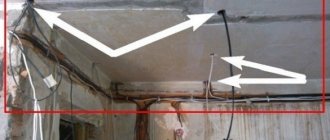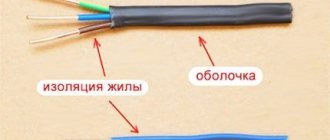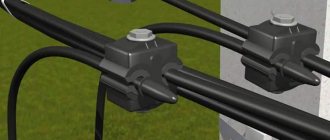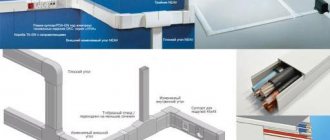Compact terminal block
Electrical appliances have long become an integral attribute of human life. It is no longer possible to imagine life without them.
Moreover, their number is constantly growing - dishwashers, toasters, microwave ovens, all kinds of gadgets and even sensors that also require power appear in apartments. In this regard, the load on electrical networks has increased significantly, so new, strict requirements are being imposed on it.
The weakest part of an electrical network is the wiring connections. Nowadays, wire clamps are actively used for switching. It is their use that ensures reliability and safety. This publication will talk about the variety of these devices.
Which is the best way to connect wires?
As a rule, the wires are connected to each other in the following ways:
- By welding. It is considered the most reliable method, but difficult to implement, since it requires a welding machine, as well as skills in handling it.
- Using terminal clamps. Affordable and reliable connection.
- Using soldering. The connection is reliable if the soldering points do not overheat.
- Using crimping with sleeves. Although the connection is quite reliable, a special tool is required.
- Using special spring clamps. Under certain conditions, it provides good contact, especially since the installation of such clamps does not require a long time.
- With bolts. This type of connection is used in difficult situations when, for example, it is necessary to connect a copper conductor to an aluminum conductor.
Which method is appropriate for a particular case is determined by the availability of certain information. It is necessary to familiarize yourself with the wiring design, with their cross-section, with possible loads, with the type of insulation, with the nature of the conductors (single-core or stranded), etc. You will also have to take into account the operating conditions.
Features of different types of terminal blocks
Let's consider the most popular types of these electrical products.
Screw type clamp
It has a fairly simple and reliable design. Used in household wiring and most electrical appliances.
The internal bridge is usually made of copper or brass. The exception is the battery terminal block. It is made from lead.
- SIP wires: types, differences from cable, features and advantages
What is a Power Cable?
- How to conveniently unwind a cable coil on site during electrical installation
Spring terminal block
Its purpose is to connect cable cores, the maximum permissible current value of which is 24A. Spring terminals can withstand loads up to 5000V.
Their advantage is the ability to simultaneously crimp eight terminals, which greatly facilitates the wiring. Fixing the wire can be either mechanical or automatic.
PPE caps
Another name is insulating terminal clamp. As you can see in the photo of the terminal clamps, outwardly it looks like a plastic cap.
The polymer from which it is made is distinguished by high heat resistance and fire resistance. This type of product provides reliable contact and can withstand loads up to 600V.
Welding connection
Welding - it is important to heat the metal, but not to melt the insulation.
Connecting wires by welding requires certain skills, since the quality of the connection directly depends on the quality of the welding. To weld wires, they are twisted and then their ends are welded. As a result, a ball appears at the end of the twist, formed as a result of the melting of the wire strands. This place ensures the reliability of the entire connection, providing minimal resistance for the passage of electric current. The lower the resistance, the less the connection heats up, ensuring the reliability of the electrical wiring. In addition to the fact that such a joint practically does not heat up, if the currents do not exceed permissible values, the welding site has increased mechanical reliability.
The disadvantage of this method is obvious, since such electrical wiring has poor maintainability. This is not surprising, since the joints are permanent. In case of repair, the connection will have to be removed by biting off the welding area with pliers. As a rule, it is not always possible to connect the wires back in the same way.
There are a number of other disadvantages associated not only with the presence of a welding machine, with the skills to work with it, but also with the presence of special electrodes, with the presence of flux, as well as with the presence of conditions: the use of welding work is not always justified. This connection method is mainly used in exceptional cases. You can, of course, practice on your own if you have a welding machine, but this training will take a lot of time and a lot of conductors. It is very important to quickly weld the twisted ends of the wires without burning the insulation. After the welding areas have cooled, they must be insulated by any available method.
Welding copper strands, tinning with tin, how to make quality stranding
"Sheath"
Knife clamps are a common design in electrical circuits for various purposes; they are also present in household appliances. One part of them is popularly called “dad”, and the other is “mama”. They are fastened by inserting into each other. Today we sell a “sheath” made of some yellow material. They don't hold the wire well. It is better to purchase them from stronger white metal.
But the “sheath” cannot be used even on apartment lighting panels. In other places, powerful crimping of the wires into the terminal is required.
Buy power cable VVGnglsElectrical wiring diagram in the garage - features of design and installation with your own hands. 120 photos of wiring examples and video instructions for replacing wiring in the garage
Which wire to use for grounding: calculation of parameters, marking and purpose of various types of wires (video instructions + 150 photos)
They have insulation of different colors, strictly corresponding to the power of the terminal block. Uninsulated ones can also be protected. Place a four-centimeter piece of heat-shrink tubing on them and heat it with a lighter. It will grip the product with a wire stronger than electrical tape.
Connecting wires by crimping
An example of crimping conductors with a sleeve
To carry out such work, you will need a special sleeve. It is very important that the sleeve is made of the same metal as the conductor cores. Before placing the wire strands into the sleeve, they are cleaned to a shine, getting rid of the insulation. After this, a special tool is taken, with which the wires are clamped, ensuring reliable contact.
Both the tool and the sleeves are different, based on how many cores they can connect to each other at the same time. It is very important to choose the right tool and sleeves, otherwise the connection may not be reliable. It is for this reason that this method is also used in exceptional cases by professional electricians.
Crimping wires in the junction box. Crimping of wires in the junction box.
Connection using terminal blocks
Electricians often use terminal blocks to connect wires, as it is simple and quite reliable. Almost all types of terminal boxes are designed for screw connections of electrical wires. It is possible to select terminal boxes for any number of wires, as well as for any cross-section. In other words, manufacturers produce these boxes in different sizes.
Connecting wires in terminal blocks
The terminal box is a plastic housing that houses terminal blocks with screws. The terminal block has special sockets into which the wire, stripped of insulation, is inserted and clamped. After the wire is clamped with a screw, you should check how reliable this connection is. To do this, just pull the wire with force. This type of connection is characterized by the fact that the connection points remain uninsulated, so it is used in conditions where the room is dry, without the presence of humidity, especially increased humidity.
A disadvantage is the fact that aluminum conductors are quite plastic and lead to weakening of the contact. This, in turn, increases its resistance, which leads to heating of the attachment point. In order for the contacts to remain reliable, they need to be tightened from time to time.
The advantages include ease of connection and its reliability, as well as low cost and connection speed. In addition, terminal blocks allow you to connect wires of different types and different cross-sections. In addition, the design of the terminal blocks is such that there is no accidental contact with live wires.
A simple terminal block and easy modification. Let's do it simply but RELIably!!
Solder connection
To connect wires in this way, you need to master soldering technology. First of all, it is necessary to strip the wires, getting rid of unnecessary insulation, to a characteristic shine. It should be said right away that soldering aluminum wires is not so easy, so you shouldn’t even try to do it without special materials. As for copper, it can be soldered without problems. To ensure high-quality soldering, the ends of the wires stripped of insulation are tinned. To do this, they are heated with a soldering iron and applied to rosin. Rosin degreases the soldering area and the solder literally envelops the end of the conductor with a thin film. After this, the ends of the wires are twisted using pliers for reliability.
After this, you can begin the soldering process, which is the final stage. We can assume that the simplest thing left is to apply the required amount of solder to the twisted area using a heated soldering iron.
After cooling, if required by the technology, the soldering joints are treated with a special compound to get rid of excess rosin or flux, after which the joints are insulated using insulating tape or another method.
Connecting wires in a junction box
This option has both its advantages and disadvantages. Soldering is a fairly reliable method of connecting wires, as long as increased currents do not flow through the wires, leading to heating of the connection point. Since solder itself is a soft alloy, and its melting point is relatively low, when the joint is periodically heated, the solder seems to evaporate, which leads to weakening of the contact. If the problem is not detected in a timely manner, this can lead to overheating of the contact and fire of the insulation. It is not difficult to imagine what consequences await the electrical wiring, and at the same time the room in which it is laid. It is for this reason that electricians do not use this connection method, although there are other negative aspects.
A negative factor is weak mechanical strength, although it depends on how well and securely the wires are twisted. Considering the fact that the solder is relatively soft, then without any problems, by applying force, the soldering point can be weakened, which is the negative factor. As a rule, experienced electricians will not take responsibility for connecting wires in this way, and this process takes a lot of time.
How to choose quality PPE
There is no uniform quality standard for these devices yet. An important factor when choosing is the total cross-sectional area of the wires. When choosing, you should try screwing the cap onto your bundle of conductors or a similar one with the appropriate dimensions.
In this case, the clamp must ensure the quality of twisting. It should not fly off with a strong jerk, pull, or the like. But when unscrewing it in the opposite direction, after all these manipulations, it should come off normally and be suitable for rewinding. Also check the spring; it should not fail, become severely deformed, or fall off after the first screw onto the connection.
Check the plastic, it should be pleasant to the touch and should also be resistant to squeezing with your fingers. Bad plastic will not shrink, but may break and crack. Good plastic will bend a little when pressed hard and then return to its original position. If you buy clamps made of low-quality plastic, they may not withstand high temperature loads.
Why is it necessary to use PPE and not do simple “Soviet” twists?
Many amateur electricians use regular twists, without installing PPE (when the wires are arranged in parallel and twisted together using pliers). And they believe that such technology has the right to life. Many give examples that simple twists from 30 years ago still do not fail. In fact, the use of twists without connecting insulating clamps is only permissible when installing a temporary connection. Such twists gradually become loose due to the constant heating and cooling of the cable, and contact is lost. 30 years ago, such technology had a right to exist, since the power of technology was much lower and people used fewer devices in everyday life.
The PPE prevents the connection from loosening due to the fixing spring, which expands slightly due to the heating of the wire and presses the conductors together more tightly. However, such a connection does not last forever, although it can last for many years.
Is it legal to use PPE?
The use of PPE is not regulated by the PUE. The document doesn't say anything about connection clamps at all. However, insulating caps, as well as any other connecting devices for low-voltage circuits for household and similar purposes, must comply with the requirements of GOST 31195.1-2012.
For the greatest safety and durability, it is recommended to use permanent connections. These include: welding, soldering, pressed sleeves.
Regular twists (without insulating caps) are prohibited by the PUE. Therefore, in some cases, it is possible to screw insulating clamps onto old strands to make connections safer and compliant with the law.
Application of spring clamps
Spring clamps for electrical wiring are popular connections for wires.
Connecting wires using special clamps with springs is considered quite controversial, since this connection method is unlikely to provide reliable, much less long-lasting contact. Basically, two types of spring clips are used - wago and PPE caps. It is not difficult to determine by appearance what type of connection you are dealing with. The operating principle is based on the use of a spring, which ensures reliable contact.
Naturally, experts are arguing about this spring. Some believe that the spring may weaken over time due to temperature, weakening the contact, which begins to overheat. Others believe that in any case, unless the operating conditions are extreme, these clamps work for many years without any complaints.
WAGO Clamps
This product appeared not so long ago, so this connection method can safely be considered revolutionary, since the connection is made quickly, ensuring high reliability. The manufacturer recommends using these clamps:
- Vago clamps are used to connect both single-core and stranded wires, the cross-section of which is in the range of 0.5-4 mm square.
- CAGE CLAMP clamps are used to connect wires with a cross-section from 0.08 to 35 mm square.
The reliability of the connection is ensured by a special metal plate located inside the clamp body. The parameters of the spring are such that it can provide reliable contact when connecting wires for a long time, without losing its properties, even if they heat up from time to time and then cool down. These indicators indicate the high quality of the products.
What's inside wago wire clamps
Despite the fact that the range of such clamps is quite extensive, for connecting wires, clamps of the 222 series, 773 and 273 series are mainly used. The series differ in that the 222 series is detachable, and the rest (773 and 273) are one-piece.
Removable clamps
Wago wire connectors - connection methods
Wago 222 clamps, which are intended for connecting wires, have several contact pads with locking flags. Before connecting the wires, the clamp flags are lifted up. The wires, stripped of insulation, are inserted into the holes, after which the flags are lowered, clamping the wire with force. That's it, the connection is complete!
The advantage of such clamps is that at any time, by raising the flag, you can pull out the wire and then clamp it again.
Wago 222 series range
Series 222 clamps are produced for the purpose of connecting from 2 to 5 conductors, both copper and aluminum, in various configurations, both single-core and stranded, with a cross-section from 0.08 to 4 mm square.
Permanent clamps
One-piece clamps are different in that they do not allow the connection to be made again if the wires are already connected. This type of clamp is not equipped with flags, so the stripped wire is simply inserted into the hole with force. The spring is placed in such a way that the wire itself pushes it aside, after which it is not so easy to pull it back out without damaging the clamp.
Wago contact terminals are not detachable
As a rule, such clamps are used to connect single-core wires with a certain rigidity. It is better not to use them to connect multi-core wires, since the connection is not so reliable.
In order for the contact to be reliable, the wires must be carefully prepared before connecting, stripped to a shine. To improve performance properties, it produces a special contact paste. This paste is placed inside the clamp, after which the paste composition eats away the oxide film and continues to protect the contact from future oxidation. When using such a paste, it is enough to remove the insulation from the conductors.
Types of mounting terminals for wago wiring
The manufacturer claims that if necessary, the wires can be pulled out of the clamps. To do this, take a clamp with a wire inserted into it and begin to rotate the wire from side to side at a small angle, while the wire is released from the clamp with force.
Lamp clamps
Such clamps are also called construction and installation terminals. With their help, connecting lamps is much faster and more convenient to use. These are Wago terminals of the 224 series. They are intended for quick and high-quality connection of various lighting equipment, in the form of lamps, chandeliers, sconces, etc. Such household appliances can be connected, regardless of the wires used, as well as their combinations. The clamps are designed for operating voltages of at least 400V and operating currents:
- For copper wires 24A.
- For 16A aluminum wires.
Methods for connecting wires in chandeliers and sconces using wago clamps
Recommended cross-section of connected wires:
- Single-core copper wires with a cross section of 1.0-2.5 mm square.
- Aluminum single-core wires with a cross-section of 2.5 mm square.
On the lighting side, the cross-section of the wires can be in the range of 0.5-2.5 mm square, and the wires can be single-core, multi-core, crimped or tinned.
Copper wires should be connected using a special paste, and aluminum wires should be cleaned to a characteristic metallic shine.
It should be noted that there are many fakes on the market, and the original clamps are not so cheap. Despite this fact, it is better to give preference to original products that guarantee a reliable connection.
Vago or twist. Which is more reliable?
PPE caps
PPE caps (connecting insulating clips) are a cylindrical plastic body, inside of which there is a conical spring. To connect the wires, just strip them of insulation and then insert them into this cap. After this, the cap is rotated several times around its axis clockwise, while the wires must remain motionless. When the cap stops rotating under the influence of external forces, we can assume that the wires are connected, forming reliable contact.
Naturally, manufacturers made sure that the caps could be selected for specific connection conditions, which is why similar products are produced in various sizes. To choose the right connectors, you need to know how they are marked.
After the letters “PPE” there are several numbers, the number of which depends on the manufacturer. For example, the designation SIZ-1 1.5-3.5 is deciphered as follows: 1 is a “regular” type of housing, with grooves located on its surface that provide better grip, and the following numbers indicate the conductors of what cross-section can be connected to each other. The designation SIZ-2 4.5-12 indicates that the body (2) has special protrusions to provide greater applied force. Well, the following numbers indicate that using this connector you can reliably connect wires with a cross-section from 4.5 to 12 mm square. It follows from this that there are no difficulties in decoding.
Using the same scheme, it is not difficult to determine the parameters of any PPE cap.
An example of marking of PPE caps and its explanation
The following table provides information when the PPE designation is followed by only one number from 1 to 5.
PPE caps and their parameters
Please pay attention to the following information. PPE caps are intended only for connecting copper wires, since aluminum wires have less mechanical strength.
Connection of wires. PPE caps.
How to choose PPE
PPE caps should be selected according to the cross-section of the wires. To do this, you need to sum up the cross-sections of each wire and compare the resulting result with the table below or with the size table that comes with the clamps. The voltage of the electrical wiring should also be taken into account.
Note!
It is recommended to select the size and overall diameter of the wires so that the diameter is as close as possible to the middle of the size range.
Types of PPE
- Standard smooth PPE is a cone-shaped, closed cap with a spring inside, without “ears” or other devices.
- PPE with ears is generally similar to standard ones, but on the outside at the base of the cone there are special “ears” for easy twisting.
- Low profile caps are more compact options for working in tight spaces.
- Caps with antioxidant - allowing you to twist aluminum cables with copper.
- Waterproof PPE with silicone filling - clamps that protect wiring from moisture can be used in conditions of high humidity and outdoors.
- Insulating clamps with two holes (on both sides) - usually used to secure grounding electrical wires. The grounding cable is brought out through the upper hole and attached to the panel or device.
- PPE with screw tightening - instead of a spring, a screw is used, the tightening of which can be adjusted from the outside.
Connection with bolts
To connect wires in this way, you need to have a bolt of the required size, a nut and several washers, which depends on the number of wires being connected. The connection is simple, affordable and very reliable.
Bolted wire connection
First of all, the wires are stripped to a metallic shine, after which a loop in the form of a ring is formed at the end of the wire without insulation, the diameter of which should be slightly larger than the diameter of the bolt. Forming such a ring is quite simple if you wrap the wire around the bolt and then tighten it. After the preparatory work, the connection process begins, which consists of the following operations:
- A washer is placed on the bolt.
- Then one of the guides is put on.
- After this, the second washer is put on.
- The second conductor is put on.
- The next washer is put on.
- The connection is securely twisted using a nut.
To make the connection reliable, the wires are twisted using tools in the form of keys for bolts. Electricians often use this type of connection, especially in industrial electrical networks where there is plenty of usable space. The main purpose is to connect copper and aluminum wires using a separating washer.
Types of collet fittings
Collet-type clamps, depending on their purpose, are divided into three main categories:
- for pipes made of hard materials;
- for pipe structures made of semi-solid materials;
- for pipes made of soft plastic.
This classification of collet clamps allows you to optimally select them for connecting pipes of various types. Thus, collet connection of pipes can be performed on products made of hard metal, softer metal-plastic and polypropylene, HDPE. It is also important that collet-type pipe clamps can be easily used even by a non-professional.
For non-metallic pipes or hoses, plastic fittings with push-in connections without a threaded nut can be used
Connection of copper and aluminum wires
As a rule, directly connecting aluminum and copper wires is not recommended for a number of reasons:
- The connection gets very hot, which leads to negative consequences.
- As a result, the contact weakens. When heated, the softer wire expands and then contracts, leaving a microscopic space between them.
To avoid such negative aspects, experts advise:
- Connect the wires using terminal blocks.
- Using Wago clamps.
- Using bolted connections.
- Using branch clamps (outdoors).
The use of other types of connections is not recommended.
CONNECTION OF COPPER AND ALUMINUM WIRES. EVERYONE SHOULD KNOW THIS











